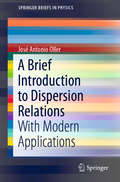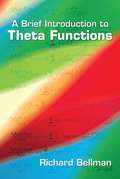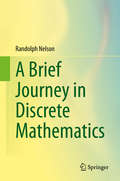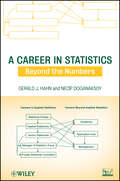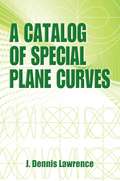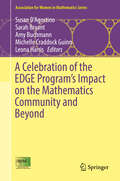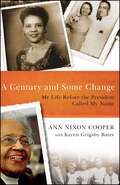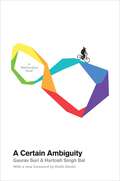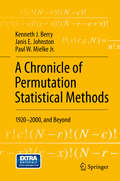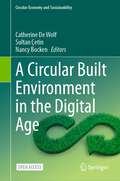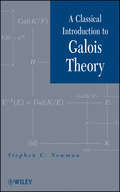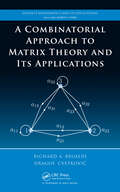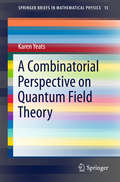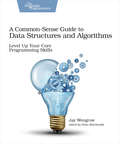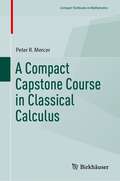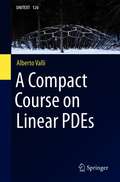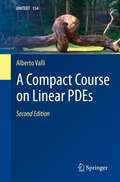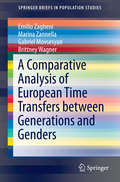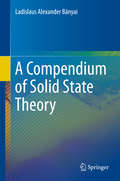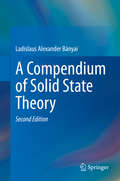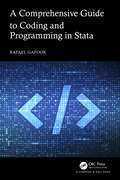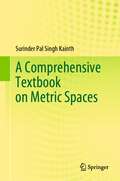- Table View
- List View
A Brief Introduction to Dispersion Relations: With Modern Applications (SpringerBriefs in Physics)
by José Antonio OllerThis text offers a brief introduction to the dispersion relations as an approach to calculate S-matrix elements, a formalism that allows one to take advantage of the analytical structure of scattering amplitudes following the basic principles of unitarity and causality.First, the case of two-body scattering is considered and then its contribution to other processes through final-state interactions is discussed. For two-body scattering amplitudes, the general expression for a partial-wave amplitude is derived in the approximation where the crossed channel dynamics is neglected. This is taken as the starting point for many interesting nonperturbative applications, both in the light and heavy quark sector. Subsequently crossed channel dynamics is introduced within the equations for calculating the partial-wave amplitudes. Some applications based on methods that treat crossed-channel dynamics perturbatively are discussed too.The last part of this introductory treatment is dedicated to the further impact of scattering amplitudes on a variety of processes through final-state interactions. Several possible approaches are discussed such as the Muskhelishvili-Omnes dispersive integral equations and other closed formulae. These different formalisms are then applied in particular to the study of resonances presenting a number of challenging properties. The book ends with a chapter illustrating the use of dispersion relations in the nuclear medium for the evaluation of the energy density in nuclear matter.
A Brief Introduction to Theta Functions (Dover Books on Mathematics)
by Richard BellmanBrief but intriguing, this monograph on the theory of elliptic functions was written by one of America's most prominent and widely read mathematicians. Richard Bellman encompasses a wealth of material in a succession of short chapters, spotlighting high points of the fundamental regions of elliptic functions and illustrating powerful and versatile analytic methods. Suitable for advanced undergraduates and graduate students in mathematics, this introductory treatment is largely self-contained. Topics include Fourier series, sufficient conditions, the Laplace transform, results of Doetsch and Kober-Erdelyi, Gaussian sums, and Euler's formulas and functional equations. Additional subjects include partial fractions, mock theta functions, Hermite's method, convergence proof, elementary functional relations, multidimensional Poisson summation formula, the modular transformation, and many other areas.
A Brief Journey in Discrete Mathematics
by Randolph NelsonThe goal of this book is to showcase the beauty of mathematics as revealed in nine topics of discrete mathematics. In each chapter, properties are explored through a series of straightforward questions that terminate with results that lie at the doorstep of a field of study. Each step along the way is elementary and requires only algebraic manipulation. This frames the wonder of mathematics and highlights the complex world that lies behind a series of simple, mathematical, deductions. Topics addressed include combinatorics, unifying properties of symmetric functions, the Golden ratio as it leads to k-bonacci numbers, non-intuitive and surprising results found in a simple coin tossing game, the playful, trick question aspect of modular systems, exploration of basic properties of prime numbers and derivations of bewildering results that arise from approximating irrational numbers as continued fraction expansions. The Appendix contains the basic tools of mathematics that are used in the text along with a numerous list of identities that are derived in the body of the book. The mathematics in the book is derived from first principles. On only one occasion does it rely on a result not derived within the text. Since the book does not require calculus or advanced techniques, it should be accessible to advanced high school students and undergraduates in math or computer science. Senior mathematicians might be unfamiliar with some of the topics addressed in its pages or find interest in the book's unified approach to discrete math.
A Career in Statistics
by Necip Doganaksoy Gerald J. HahnA valuable guide to a successful career as a statisticianA Career in Statistics: Beyond the Numbers prepares readers for careers in statistics by emphasizing essential concepts and practices beyond the technical tools provided in standard courses and texts. This insider's guide from internationally recognized applied statisticians helps readers decide whether a career in statistics is right for them, provides hands-on guidance on how to prepare for such a career, and shows how to succeed on the job.The book provides non-technical guidance for a successful career. The authors' extensive industrial experience is supplemented by insights from contributing authors from government and academia, Carol Joyce Blumberg, Leonard M. Gaines, Lynne B. Hare, William Q. Meeker, and Josef Schmee. Following an introductory chapter that provides an overview of the field, the authors discuss the various dimensions of a career in applied statistics in three succinct parts:The Work of a Statistician describes the day-to-day activities of applied statisticians in business and industry, official government, and various other application areas, highlighting the work environment and major on-the-job challengesPreparing for a Successful Career in Statistics describes the personal traits that characterize successful statisticians, the education that they need to acquire, and approaches for securing the right jobBuilding a Successful Career as a Statistician offers practical guidance for addressing key challenges that statisticians face on the job, such as project initiation and execution, effective communication, publicizing successes, ethical considerations, and gathering good data; alternative career paths are also describedThe book concludes with an in-depth examination of careers for statisticians in academia as well as tips to help them stay on top of their field throughout their careers. Each chapter includes thought-provoking discussion questions and a Major Takeaways section that outlines key concepts. Real-world examples illustrate key points, and an FTP site provides additional information on selected topics.A Career in Statistics is an invaluable guide for individuals who are considering or have decided on a career in statistics as well as for statisticians already on the job who want to accelerate their path to success. It also serves as a suitable book for courses on statistical consulting, statistical practice, and statistics in the workplace at the undergraduate and graduate levels.
A Catalog of Special Plane Curves (Dover Books on Mathematics)
by J. Dennis LawrenceAmong the largest, finest collections available--illustrated not only once for each curve, but also for various values of any parameters present. Covers general properties of curves and types of derived curves. Curves illustrated by a CalComp digital incremental plotter. 12 illustrations.
A Celebration of the EDGE Program’s Impact on the Mathematics Community and Beyond (Association for Women in Mathematics Series #18)
by Sarah Bryant Susan D’Agostino Amy Buchmann Michelle Craddock Guinn Leona HarrisThe Enhancing Diversity in Graduate Education (EDGE) Program began twenty years ago to provide support for women entering doctoral programs in the mathematical sciences. With a steadfast commitment to diversity among participants, faculty, and staff, EDGE initially alternated between Bryn Mawr and Spelman Colleges. In later years, EDGE has been hosted on campuses around the nation and expanded to offer support for women throughout their graduate school and professional careers. The refereed papers in A Celebration of the EDGE Program’s Impact on the Mathematics Community and Beyond range from short memoirs, to pedagogical studies, to current mathematics research. All papers are written by former EDGE participants, mentors, instructors, directors, and others connected to EDGE. Together, these papers offer compelling testimony that EDGE has produced a diverse new generation of leaders in the mathematics community. This volume contains technical and non-technical works, and it is intended for a far-reaching audience, including mathematicians, mathematics teachers, diversity officers, university administrators, government employees writing educational or science policy, and mathematics students at the high school, college, and graduate levels. By highlighting the scope of the work done by those supported by EDGE, the volume offers strong evidence of the American Mathematical Society’s recognition that EDGE is "a program that makes a difference.”This volume offers unique testimony that a 20-year old summer program has expanded its reach beyond the summer experience to produce a diverse new generation of women leaders, nearly half of whom are underrepresented women. While some books with a women-in-math theme focus only on one topic such as research or work-life balance, this book's broad scope includes papers on mathematics research, teaching, outreach, and career paths.
A Century and Some Change: My Life Before the President Called My Name
by Ann Nixon CooperPresident-elect Barack Obama reflected on the life of Ann Nixon Cooper on Tuesday, November 4, 2008, singling her out of millions of voters, he said, because she was “born just a generation past slavery; a time when there were no cars on the road or planes in the sky, when someone like her couldn’t vote for two reasons—because she was a woman and because of the color of her skin.” Energized by this history-making presidential campaign, Mrs. Cooper now shares her story, her life before the president called her name, in her own voice, with the assistance of bestselling author Karen Grigsby Bates. Mrs. Cooper is the beloved matriarch of a large and accomplished family who live throughout the country, and a long-celebrated elder in the city of Atlanta, Georgia, where she raised her children and has lived most of her long and extraordinary life. She was born and raised in Bedford County, Tennessee, near Nashville, on January 9, 1902. Her father was a tenant farmer, and her mother worked at home, taking care of the children. She met her husband, Dr. Albert Berry Cooper II, while he attended Meharry Medical College in Nashville. They settled in his hometown of Atlanta, where he established a successful practice in dentistry. When president-elect Obama referred to her in his speech, she became a celebrity, sought after by media from all over the world. In Mrs. Cooper’swords, “All of a sudden, everyone wanted to talkto me. . . . It was nice they were interested, I guess,but I wasn’t so thrilled that media and ordinaryfolk were acting as if the only exciting thing I’d everdone was vote for a black man for president. . . .I’d had a life before CNN and the rest ‘discovered’me.” And she is going to tell you about it.
A Certain Ambiguity: A Mathematical Novel
by Gaurav Suri Hartosh Singh BalWhile taking a class on infinity at Stanford in the late 1980s, Ravi Kapoor discovers that he is confronting the same mathematical and philosophical dilemmas that his mathematician grandfather had faced many decades earlier--and that had landed him in jail. Charged under an obscure blasphemy law in a small New Jersey town in 1919, Vijay Sahni is challenged by a skeptical judge to defend his belief that the certainty of mathematics can be extended to all human knowledge--including religion. Together, the two men discover the power--and the fallibility--of what has long been considered the pinnacle of human certainty, Euclidean geometry. As grandfather and grandson struggle with the question of whether there can ever be absolute certainty in mathematics or life, they are forced to reconsider their fundamental beliefs and choices. Their stories hinge on their explorations of parallel developments in the study of geometry and infinity--and the mathematics throughout is as rigorous and fascinating as the narrative and characters are compelling and complex. Moving and enlightening, A Certain Ambiguity is a story about what it means to face the extent--and the limits--of human knowledge.
A Certain Uncertainty: Nature's Random Ways
by Mark P. SilvermanBased around a series of real-life scenarios, this engaging introduction to statistical reasoning will teach you how to apply powerful statistical, qualitative and probabilistic tools in a technical context. From analysis of electricity bills, baseball statistics, and stock market fluctuations, through to profound questions about physics of fermions and bosons, decaying nuclei, and climate change, each chapter introduces relevant physical, statistical and mathematical principles step-by-step in an engaging narrative style, helping to develop practical proficiency in the use of probability and statistical reasoning. With numerous illustrations making it easy to focus on the most important information, this insightful book is perfect for students and researchers of any discipline interested in the interwoven tapestry of probability, statistics, and physics.
A Chronicle of Permutation Statistical Methods: 1920–2000, and Beyond
by Kenneth J. Berry Janis E. Johnston Paul W. Mielke Jr.The focus of this book is on the birth and historical development of permutation statistical methods from the early 1920s to the near present. Beginning with the seminal contributions of R. A. Fisher, E. J. G. Pitman, and others in the 1920s and 1930s, permutation statistical methods were initially introduced to validate the assumptions of classical statistical methods. Permutation methods have advantages over classical methods in that they are optimal for small data sets and non-random samples, are data-dependent, and are free of distributional assumptions. Permutation probability values may be exact, or estimated via moment- or resampling-approximation procedures. Because permutation methods are inherently computationally-intensive, the evolution of computers and computing technology that made modern permutation methods possible accompanies the historical narrative. Permutation analogs of many well-known statistical tests are presented in a historical context, including multiple correlation and regression, analysis of variance, contingency table analysis, and measures of association and agreement. A non-mathematical approach makes the text accessible to readers of all levels.
A Circular Built Environment in the Digital Age (Circular Economy and Sustainability)
by Catherine De Wolf Nancy Bocken Sultan ÇetinThis open access book offers a comprehensive exploration of the digital innovations that have emerged in recent years for the circular built environment. Each chapter is meticulously crafted to ensure that both academic readers and industry practitioners can grasp the inner workings of each digital technology, understand its relevance to the circular built environment, examine real-life implementations, and appreciate the intriguing business models behind them. Our primary objective is to blend scholarly knowledge with practical inspiration by providing real-life case studies for each innovation. The authors, who possess extensive expertise in their respective fields, have contributed chapters dedicated to digital technologies within their areas of specialization. The book is organized into three distinct parts. The first part focuses on data-driven digital technologies and delves into how their capabilities can facilitate the transition to a circular built environment. Essential aspects such as building information modeling (BIM), digital twins, geographical information systems (GIS), scanning technologies, artificial intelligence (AI), data templates, and material passports are explored as vital tools for data collection, integration, and analysis in the context of circular construction. In the second part, various digital technologies for design and fabrication are introduced. Topics covered include computational design algorithms, additive and subtractive manufacturing, robotic manufacturing, and extended reality. These discussions shed light on how these technologies can be leveraged to enhance design and fabrication processes within the circular built environment. Finally, the last part of the book presents emerging digital concepts related to business and governance. It explores the role of deconstruction and reverse logistics, blockchain technology, digital building logbooks, and innovative business models as enablers of circularity in the built environment. The book concludes with a chapter dedicated to digital transformation and its potential to propel the built environment towards a regenerative future. In addition to the substantive content, the book features forewords and perspectives from esteemed experts, providing valuable economic and creative insights to complement its comprehensive approach.
A Classical Introduction to Galois Theory
by Stephen C. NewmanExplore the foundations and modern applications of Galois theory Galois theory is widely regarded as one of the most elegant areas of mathematics. A Classical Introduction to Galois Theory develops the topic from a historical perspective, with an emphasis on the solvability of polynomials by radicals. The book provides a gradual transition from the computational methods typical of early literature on the subject to the more abstract approach that characterizes most contemporary expositions. The author provides an easily-accessible presentation of fundamental notions such as roots of unity, minimal polynomials, primitive elements, radical extensions, fixed fields, groups of automorphisms, and solvable series. As a result, their role in modern treatments of Galois theory is clearly illuminated for readers. Classical theorems by Abel, Galois, Gauss, Kronecker, Lagrange, and Ruffini are presented, and the power of Galois theory as both a theoretical and computational tool is illustrated through: A study of the solvability of polynomials of prime degree Development of the theory of periods of roots of unity Derivation of the classical formulas for solving general quadratic, cubic, and quartic polynomials by radicals Throughout the book, key theorems are proved in two ways, once using a classical approach and then again utilizing modern methods. Numerous worked examples showcase the discussed techniques, and background material on groups and fields is provided, supplying readers with a self-contained discussion of the topic. A Classical Introduction to Galois Theory is an excellent resource for courses on abstract algebra at the upper-undergraduate level. The book is also appealing to anyone interested in understanding the origins of Galois theory, why it was created, and how it has evolved into the discipline it is today.
A Combinatorial Approach to Matrix Theory and Its Applications (Discrete Mathematics and Its Applications)
by Richard A. Brualdi Dragos CvetkovicUnlike most elementary books on matrices, A Combinatorial Approach to Matrix Theory and Its Applications employs combinatorial and graph-theoretical tools to develop basic theorems of matrix theory, shedding new light on the subject by exploring the connections of these tools to matrices. Placing combinatorial and graph-theoretical tools at the forefront of the development of matrix theory, this book uses graphs to explain basic matrix construction, formulas, computations, ideas, and results. It presents material rarely found in other books at this level, including Gersgorin's theorem and its extensions, the Kronecker product of matrices, sign-nonsingular matrices, and the evaluation of the permanent matrix. The authors provide a combinatorial argument for the classical Cayley-Hamilton theorem and a combinatorial proof of the Jordan canonical form of a matrix. They also describe several applications of matrices in electrical engineering, physics, and chemistry.
A Combinatorial Perspective on Quantum Field Theory (SpringerBriefs in Mathematical Physics #15)
by Karen YeatsThis book explores combinatorial problems and insights in quantum field theory. It is not comprehensive, but rather takes a tour, shaped by the author's biases, through some of the important ways that a combinatorial perspective can be brought to bear on quantum field theory. Among the outcomes are both physical insights and interesting mathematics. The book begins by thinking of perturbative expansions as kinds of generating functions and then introduces renormalization Hopf algebras. The remainder is broken into two parts. The first part looks at Dyson-Schwinger equations, stepping gradually from the purely combinatorial to the more physical. The second part looks at Feynman graphs and their periods. The flavour of the book will appeal to mathematicians with a combinatorics background as well as mathematical physicists and other mathematicians.
A Common-Sense Guide to Data Structures and Algorithms: Level Up Your Core Programming Skills
by Jay Wengrow"Algorithms and data structures are much more than abstract concepts. Mastering them enables you to write code that runs faster and more efficiently, which is particularly important for today’s web and mobile apps. This book takes a practical approach to data structures and algorithms, with techniques and real-world scenarios that you can use in your daily production code. Graphics and examples make these computer science concepts understandable and relevant. You can use these techniques with any language; examples in the book are in JavaScript, Python, and Ruby.Use Big O notation, the primary tool for evaluating algorithms, to measure and articulate the efficiency of your code, and modify your algorithm to make it faster. Find out how your choice of arrays, linked lists, and hash tables can dramatically affect the code you write. Use recursion to solve tricky problems and create algorithms that run exponentially faster than the alternatives. Dig into advanced data structures such as binary trees and graphs to help scale specialized applications such as social networks and mapping software. You’ll even encounter a single keyword that can give your code a turbo boost. Jay Wengrow brings to this book the key teaching practices he developed as a web development bootcamp founder and educator.Use these techniques today to make your code faster and more scalable."
A Compact Capstone Course in Classical Calculus (Compact Textbooks in Mathematics)
by Peter R. MercerThis textbook offers undergraduates a self-contained introduction to advanced topics not covered in a standard calculus sequence. The author’s enthusiastic and engaging style makes this material, which typically requires a substantial amount of study, accessible to students with minimal prerequisites. Readers will gain a broad knowledge of the area, with approaches based on those found in recent literature, as well as historical remarks that deepen the exposition. Specific topics covered include the binomial theorem, the harmonic series, Euler's constant, geometric probability, and much more. Over the fifteen chapters, readers will discover the elegance of calculus and the pivotal role it plays within mathematics. A Compact Capstone Course in Classical Calculus is ideal for exploring interesting topics in mathematics beyond the standard calculus sequence, particularly for undergraduates who may not be taking more advanced math courses. It would also serve as a useful supplement for a calculus course and a valuable resource for self-study. Readers are expected to have completed two one-semester college calculus courses.
A Compact Course on Linear PDEs (UNITEXT #126)
by Alberto ValliThis textbook is devoted to second order linear partial differential equations. The focus is on variational formulations in Hilbert spaces. It contains elliptic equations, including some basic results on Fredholm alternative and spectral theory, some useful notes on functional analysis, a brief presentation of Sobolev spaces and their properties, saddle point problems, parabolic equations and hyperbolic equations. Many exercises are added, and the complete solution of all of them is included. The work is mainly addressed to students in Mathematics, but also students in Engineering with a good mathematical background should be able to follow the theory presented here.
A Compact Course on Linear PDEs (UNITEXT #154)
by Alberto ValliThis textbook is devoted to second order linear partial differential equations. The focus is on variational formulations in Hilbert spaces. It contains elliptic equations, including the biharmonic problem, some useful notes on functional analysis, a brief presentation of Sobolev spaces and their properties, some basic results on Fredholm alternative and spectral theory, saddle point problems, parabolic and linear Navier-Stokes equations, and hyperbolic and Maxwell equations. Almost 80 exercises are added, and the complete solution of all of them is included. The work is mainly addressed to students in Mathematics, but also students in Engineering with a good mathematical background should be able to follow the theory presented here. This second edition has been enriched by some new sections and new exercises; in particular, three important equations are now included: the biharmonic equation, the linear Navier-Stokes equations and the Maxwell equations.
A Comparative Analysis of European Time Transfers between Generations and Genders (SpringerBriefs in Population Studies)
by Emilio Zagheni Marina Zannella Gabriel Movsesyan Brittney WagnerThis comparative study of European time transfers reveals the full extent of transfers in the form of unpaid work and highlights the existence of important gender differences in household time production. A large quantity of goods and services are produced by household members for their own consumption, without involving market transactions. Despite the economic and social importance of unpaid work, these productive activities are largely invisible to traditional national economic accounts. As a consequence, standard measures of intergenerational transfers typically ignore household production, and thus underestimate the overall value of goods and services produced over the life cycle; in particular, the economic contribution of females. The book uses a life course approach to offer policy-relevant insights into the effect of demographic and social change on intergenerational ties and gender inequality in household production.
A Compendium of Solid State Theory
by Ladislaus Alexander BányaiDesigned to sit alongside more conventional established condensed matter physics textbooks, this compact volume offers a concise presentation of the principles of solid state theory, ideal for advanced students and researchers requiring an overview or a quick refresher on a specific topic.The book starts from the one-electron theory of solid state physics, moving through electron-electron interaction and many-body approximation schemes, to lattice oscillations and their interactions with electrons. Subsequent chapters discuss transport theory and optical properties, phase transitions and some properties of low-dimensional semiconductors. Throughout the text, mathematical proofs are often only sketched, and the final chapter of the book reviews some of the key concepts and formulae used in theoretical physics.Aimed primarily at graduate and advanced undergraduate students taking courses on condensed matter theory, the book serves as a study guide to reinforce concepts learned through conventional solid state texts. Researchers and lecturers will also find it a useful resource as a concise set of notes on fundamental topics.
A Compendium of Solid State Theory
by Ladislaus Alexander BányaiDesigned to sit alongside more conventional established condensed matter physics textbooks, this compact volume offers a concise presentation of the principles of solid state theory, ideal for advanced students and researchers requiring an overview or a quick refresher on a specific topic.The book starts from the one-electron theory of solid state physics, moving through electron-electron interaction and many-body approximation schemes, to lattice oscillations and their interactions with electrons. Subsequent chapters discuss transport theory and optical properties, phase transitions and some properties of low-dimensional semiconductors. This extensively expanded second edition includes new material on adiabatic perturbation theory, kinetic coefficients, the Nyquist theorem, Bose condensation, and the field-theoretical approach to non-relativistic quantum electrodynamics. Throughout the text, mathematical proofs are often only sketched, and the final chapter of the book reviews some of the key concepts and formulae used in theoretical physics.Aimed primarily at graduate and advanced undergraduate students taking courses on condensed matter theory, the book serves as a study guide to reinforce concepts learned through conventional solid state texts. Researchers and lecturers will also find it a useful resource as a concise set of notes on fundamental topics.
A Comprehensive Course in Number Theory
by Alan BakerDeveloped from the author's popular text, A Concise Introduction to the Theory of Numbers, this book provides a comprehensive initiation to all the major branches of number theory. Beginning with the rudiments of the subject, the author proceeds to more advanced topics, including elements of cryptography and primality testing, an account of number fields in the classical vein including properties of their units, ideals and ideal classes, aspects of analytic number theory including studies of the Riemann zeta-function, the prime-number theorem and primes in arithmetical progressions, a description of the Hardy–Littlewood and sieve methods from respectively additive and multiplicative number theory and an exposition of the arithmetic of elliptic curves. The book includes many worked examples, exercises and further reading. Its wider coverage and versatility make this book suitable for courses extending from the elementary to beginning graduate studies.
A Comprehensive Guide to Coding and Programming in Stata
by Rafael GafoorThis book is an introductory guide to programming and coding in Stata. Commonly encountered code in the field of medical statistics as well as the analyses of observational data are presented.For those who are involved in the analyses of observational studies, the need to sometimes assemble large datasets will necessitate a detailed understanding of loops and macros. This book covers these materials early on and then describes other commonly required coding commands.For those who program in a controlled environment (.e.g. medical statisticians who perform analyses for regulatory bodies), the production of log files, a suggested folder structure and analysis pathway are covered. This book also includes a wide range of tabulation commands and other methods of producing tables of descriptive statistics. The text also then provides a clear explanation of how to perform some inferential analyses (including how to extract and format the coefficients for use in subsequent reports).The focus on coding allows beginners to grasp the basics of coding and programming, as well as allowing established researchers to hone their skills and become more advanced programmers.Key Features: Covers the fundamental of using and understanding Stata. Able to be used by anyone looking to learn the basics of coding. Introduces and explains difficult concepts such as macros from the outset.
A Comprehensive Introduction to Sub-Riemannian Geometry (Cambridge Studies in Advanced Mathematics #181)
by Ugo Boscain Andrei Agrachev Davide BarilariSub-Riemannian geometry is the geometry of a world with nonholonomic constraints. In such a world, one can move, send and receive information only in certain admissible directions but eventually can reach every position from any other. In the last two decades sub-Riemannian geometry has emerged as an independent research domain impacting on several areas of pure and applied mathematics, with applications to many areas such as quantum control, Hamiltonian dynamics, robotics and Lie theory. This comprehensive introduction proceeds from classical topics to cutting-edge theory and applications, assuming only standard knowledge of calculus, linear algebra and differential equations. The book may serve as a basis for an introductory course in Riemannian geometry or an advanced course in sub-Riemannian geometry, covering elements of Hamiltonian dynamics, integrable systems and Lie theory. It will also be a valuable reference source for researchers in various disciplines.
A Comprehensive Textbook on Metric Spaces
by Surinder Pal KainthThis textbook provides a comprehensive course in metric spaces. Presenting a smooth takeoff from basic real analysis to metric spaces, every chapter of the book presents a single concept, which is further unfolded and elaborated through related sections and subsections. Apart from a unique new presentation and being a comprehensive textbook on metric spaces, it contains some special concepts and new proofs of old results, which are not available in any other book on metric spaces. It has individual chapters on homeomorphisms and the Cantor set. This book is almost self-contained and has an abundance of examples, exercises, references and remarks about the history of basic notions and results. Every chapter of this book includes brief hints and solutions to selected exercises. It is targeted to serve as a textbook for advanced undergraduate and beginning graduate students of mathematics.
